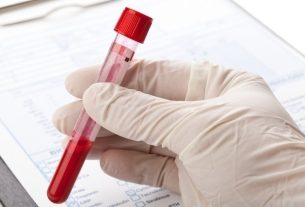The presence of excess protein in urine is scientifically known as proteinuria and may be indicative of kidney problems, high blood pressure or diabetes.
The kidneys filter the blood, eliminating what is not important and retaining what is important for the body, however, in some situations, the kidneys allow proteins to pass through their filters, causing an increase in the amount of protein in the urine.
When the presence of protein is not associated with other symptoms or diseases, it is considered isolated proteinuria, which may be a consequence of stress or intense physical activity, for example.

Causes and types of proteinuria
An increase in the amount of proteins in the urine can occur due to several situations and, depending on the cause and the time that the presence of proteins in the urine can be detected, proteinuria can be classified into:
1. Transient proteinuria
Situations that cause a temporary increase in protein in the urine are:
- Dehydration;
- Emotional stress;
- Exposure to extreme cold;
- Fever;
- Intense physical exercise.
These situations are not a cause for concern, and are normally temporary.
2. Orthostatic proteinuria
In orthostatic proteinuria, the amount of protein in the urine increases when standing, and is usually seen in children and young people who are tall and thin. Protein secretion in urine happens mainly during the day, when activity levels are high, so if urine is collected in the morning, it should not contain protein.
3. Persistent proteinuria
Diseases and situations that cause persistently high levels of protein in the urine may be the following:
- Amyloidosis, which consists of an abnormal accumulation of proteins in organs;
- Prolonged use of some medications, such as non-steroidal anti-inflammatory drugs;
- Chronic disease or polycystic kidney disease of the kidneys or infection of the kidneys;
- Heart disease or infection of the inner lining of the heart;
- Hodgkin’s lymphoma and multiple myeloma;
- Glomerulonephritis, which consists of inflammation of the renal glomeruli;
- Diabetes, because it affects the kidneys’ ability to filter the blood or reabsorb proteins in the blood;
- High blood pressure, which damages the arteries located in and around the kidneys, negatively affecting the function of these organs;
- IgA nephropathy, which consists of kidney inflammation resulting from an accumulation of the immunoglobulin A antibody;
- Sarcoidosis, which consists of the development and growth of clusters of inflammatory cells in organs;
- Sickle cell anemia;
- Lupus;
- Malaria;
- Rheumatoid arthritis.
High levels of protein in urine can also occur during pregnancy, and may be related to several factors, such as increased kidney work to filter excess fluids, excess stress, urinary infection, or in more serious cases, pre-eclampsia. See more about these symptoms of proteinuria in pregnancy.
Pre-eclampsia is a serious complication of pregnancy, which must be detected as soon as possible, to avoid health problems in the pregnant woman, and may be associated with other factors such as increased blood pressure, headache or swelling in the body. Learn more about pre-eclampsia.
Possible symptoms
Proteinuria can be the result of several situations, with the symptoms not being specifically related to the presence of proteins in the urine, but rather to the causes.
However, if proteinuria is indicative of kidney disease, other symptoms may appear such as nausea and vomiting, decreased urine production, swelling in the ankles and around the eyes, unpleasant taste in the mouth, fatigue, shortness of breath and appetite, pallor, dryness and generalized itching of the skin. In addition, urine may also be foamy and cause pain and a burning sensation when urinating. Understand what kidney failure is, its symptoms and how it is treated.
Treatment depends largely on the cause of proteinuria, so you must go to the doctor to make the correct diagnosis and determine what is causing excess protein in the urine.
How the exam is carried out
Proteins can be easily detected in urine through the type 1 urine test, also known as EAS, in which a strip of paper with chemical reagents is dipped into the urine sample, and if there is a large amount of protein in the sample, a portion specific strip changes color. See how to understand the results of the EAS exam.
If it is found that the urine contains large amounts of protein, a 24-hour urine test can also be performed to measure protein and creatinine clearance, which helps to evaluate and control kidney function, thus helping to detect possible diseases. . Find out everything about the 24-hour urine test.
How to prepare for the exam
Before taking the exam, you should speak to the doctor in order to prepare correctly, so that the result is not wrong. Therefore, it may be necessary to stop taking some medications or supplements that may interfere with the test results.
Other factors may interfere with the test, such as dehydration or not drinking enough water, having undergone a radiological contrast exam in which some type of dye was used, having been subjected to a situation of extreme emotional stress, extreme physical exercise, if you have a urinary tract infection, or if your urine is mixed with vaginal secretions, blood or semen.
If the urine test is carried out on women, it is very important to wait 5 to 10 days after the end of the menstrual cycle before taking the test, to avoid contaminating the urine with traces of period blood.

Sign up for our newsletter and stay up to date with exclusive news
that can transform your routine!
Warning: Undefined array key "title" in /home/storelat/public_html/wp-content/plugins/link-whisper-premium/templates/frontend/related-posts.php on line 12
Warning: Undefined array key "title_tag" in /home/storelat/public_html/wp-content/plugins/link-whisper-premium/templates/frontend/related-posts.php on line 13



